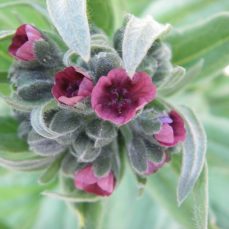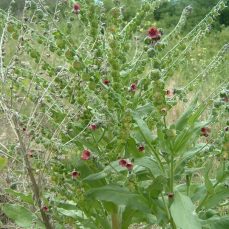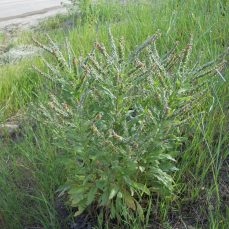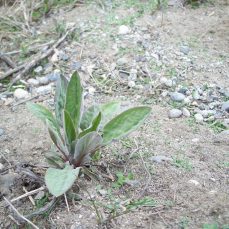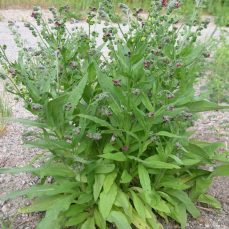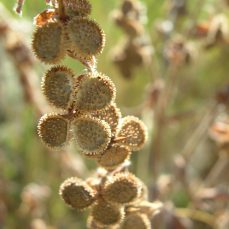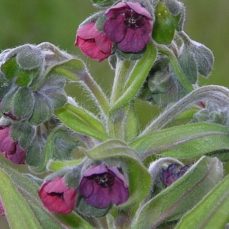
Photo credit: N.Bakker
Synonyms
Other common names:
- Dog burr
- Gypsy flower
- Rats and mice
- Houndstooth
ID Characteristics
General: Hound’s tongue is a biennial (2 years to grow) or short-lived perennial (lives 2+ years) in the Boraginaceae family.
Flowers: Several narrow flower clusters that are slightly coiled. Flowers are dull reddish-purple, drooping slightly along slender stalks, and have 5 petals each.
Stems: First-year plants form a rosette and bolt the following year, reaching up to 1.5 m tall with stout, upright stems. Stems are covered in hair and the upper portion is often branched.
Leaves: Rosette leaves are up to 30 cm long and dog tongue-shaped (hence the plant’s common name), with broad tips that taper at the base. Stem leaves are smaller and stalkless with smooth edges and distinctive veins; they grow on alternate sides of the stems. Mature plants develop rough, hairy leaves.
Roots: Plants have a thick, black, woody taproot.
Fruits: Seeds are brown to grayish-brown and have a rounded triangular shape. They are covered with short, hooked bristles and cling to clothing and fur like velcro.
Similar Species
Invasive:
Common comfrey (Symphytum officinale) is found throughout the Sea to Sky. Unlike Hound’s-tongue, Common Comfrey has smooth seeds and long, funnel-shaped flowers. To add, it generally has wider leaves and narrower sepals.

Habitat and Origin
Hound’s tongue is native to western Asia and eastern Europe, and was likely introduced to North America unintentionally, as a seed contaminant. Some use it to relieve skin irritations, sore throats, and coughs.
Hound’s tongue is shade tolerant and requires more than 30 cm of rain annually. It thrives in forest openings cleared by logging operations and road construction. It is commonly found in pastures, along roadsides, and abandoned fields.
How it Spreads
Hound’s tongue reproduces by seed, producing up to 2,000 barbed seeds per year. Seeds are viable for up to 1 year when they are buried in the soil and up to 3 years on the surface.
Velcro-like seeds attach to the fur of animals and other carriers such as clothing, and vehicles. Over-grazing and disturbance can also encourage the spread of Hound’s tongue.
Impacts
Ecological:
- Contains toxic pyrrolizidine alkaloids, which inhibit liver cells from reproducing, poisoning wildlife if ingested.
Health:
- Can cause dermatitis (skin irritation) in humans.
Economic:
- Poisonous to livestock, particularly horses & cattle, if ingested.
- Seeds cling to livestock fur and can become embedded in the eye or eyelids, causing damage.
- Bur-like seeds can impact recreational activities.
- Infestations in hay fields reduce available forage.
Stop the Spread
Hound’s-tongue is found in the Sea to Sky region, but with a very limited distribution. The goal is to eradicate this species from the region, and to prevent new introductions.
Learn to identify Hound’s-tongue: use the images presented on this profile page to learn how to identify Hound’s-tongue.
What to do if you spot it: You can report any hound’s-tongue sighting by visiting our reporting page.
DO:
- Regularly monitor properties for weed infestations.
- Minimize soil disturbances and promptly revegetate disturbed areas to prevent the growth of hound’s-tongue.
- Check wildflower mixes to ensure that they do not contain hound’s-tongue.
- Ensure all flowering heads or buds are bagged or covered to prevent spread during transport to designated disposal sites.
DO NOT:
- Unload, park or store equipment or vehicles in infested areas; remove plant material from any equipment, vehicles or clothing used in such areas and wash equipment and vehicles at designated cleaning sites before leaving infested areas.
- Plant hound’s-tongue in a garden, no matter how well-contained its enclosure may seem.
- Compost any flowering heads or buds. Instead, dispose of hound’s tongue in the general/household waste stream at the landfill as the seeds can persist the composting process.
- Move soil, gravel, or fill that has been contaminated with hound’s tongue.
Control
Mechanical
- Hand-pull to remove small infestations.
- Remove as much of the taproot as possible, otherwise the plant may re-sprout.
- Cutting second-year plants down before they set seeds will reduce seed production and spread.
- If plants are cut close to the ground, many plants will not re-grow.
Chemical
- Metsulfuron is effective for hound’s tongue control whenever the plant is actively growing.
- First-year rosettes can be controlled with 2,4-D, but this herbicide is fairly ineffective on second-year plants.
We recommend that any herbicide application is carried out by a person holding a valid BC Pesticide Applicator Certificate. Before selecting and applying herbicides, you must review and follow herbicide labels and application rates; municipal, regional, provincial and federal laws and regulations; species-specific treatment recommendations, and site-specific goals and objectives.
Biological
Some biological agents exist, including a flea beetle (Longitarsus quadriguttatus) and a weevil (Mongulones crucifer).
Integrated Control
It is best to seed disturbed or bare soil with competitive species after mechanical treatment to prevent re-infestation.
Sea to Sky Distribution
Hound’s Tongue Factsheet
References
- Fraser Valley Invasive Species Society, Hound’s Tongue
- Government of BC, A Guide to Weeds in British Columbia. Hound’s Tongue
- Invasive Species Council of BC, Hound’s Tongue
- King County, Houndstongue
- Lillooet Regional Invasive Species Society, Hound’s Tongue (Cynoglossum officinale L.)
- National Invasive Species Information Center, Houndstongue
- Okanagan Invasive Species Online, Hound’s-Tongue
- Washington State Noxious Weed Control Board, Houndstongue





